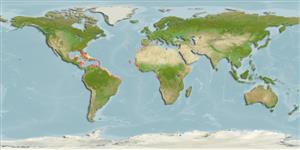Environment: milieu / climate zone / depth range / distribution range
Ecología
marino asociado a arrecife; rango de profundidad 0 - 5 m (Ref. 3723), usually 0 - 2 m (Ref. 40849). Subtropical; 43°N - 13°S
Western Atlantic: Massachusetts, USA and northern Gulf of Mexico to Brazil, including the Caribbean Sea (Ref. 3723); absent in Bermuda. Eastern Atlantic: Cape Verde and Dakar, Senegal to Luanda, Angola (Ref. 4497).
Length at first maturity / Tamaño / Peso / Age
Maturity: Lm 19.3 range ? - ? cm
Max length : 55.0 cm TL macho / no sexado; (Ref. 2683); common length : 35.0 cm TL macho / no sexado; (Ref. 3633); peso máximo publicado: 200.00 g (Ref. 5217)
Radios blandos dorsales (total): 13-14; Radios blandos anales: 12 - 13. No ridge between nostril and eye (Ref. 26938).
An inshore, surface-dwelling species forming sizeable schools (Ref. 3723). Feeds mainly on sea grasses and small fishes (Ref. 3723). Mainly used as bait for offshore game fishes such as sailfishes and marlins; utilized as a food fish in the West Indies (Ref. 3723).
Life cycle and mating behavior
Madurez | Reproducción | Puesta | Huevos | Fecundidad | Larva
Robins, C.R. and G.C. Ray, 1986. A field guide to Atlantic coast fishes of North America. Houghton Mifflin Company, Boston, U.S.A. 354 p. (Ref. 7251)
IUCN Red List Status (Ref. 130435)
Threat to humans
Reports of ciguatera poisoning (Ref. 30911)
Human uses
Pesquerías: escaso valor comercial; carnada: usually
Más información
ReferenciasAcuiculturaPerfil de acuiculturaRazasGenéticaElectrophoresesheritabilidadEnfermedadesProcesamientoNutrientsMass conversion
Herramientas
Special reports
Download XML
Fuentes de Internet
Estimates based on models
Preferred temperature (Ref.
123201): 20.5 - 28.1, mean 27.3 °C (based on 858 cells).
Phylogenetic diversity index (Ref.
82804): PD
50 = 0.5005 [Uniqueness, from 0.5 = low to 2.0 = high].
Bayesian length-weight: a=0.00380 (0.00278 - 0.00520), b=3.08 (3.02 - 3.14), in cm total length, based on LWR estimates for this species (Ref.
93245).
Nivel trófico (Ref.
69278): 2.3 ±0.1 se; based on diet studies.
Generation time: 1.9 ( na - na) years. Estimated as median ln(3)/K based on 2
growth studies.
Resiliencia (Ref.
120179): Medio, población duplicada en un tiempo mínimo de 1.4-4.4 años (K=0.58 questionable; assuming tmax>3).
Prior r = 0.46, 95% CL = 0.28 - 0.77, Based on 1 stock assessment.
Fishing Vulnerability (Ref.
59153): Low to moderate vulnerability (27 of 100).
Climate Vulnerability (Ref.
125649): High to very high vulnerability (75 of 100).
Nutrients (Ref.
124155): Calcium = 62.8 [19.5, 142.1] mg/100g; Iron = 0.681 [0.267, 1.717] mg/100g; Protein = 18.4 [15.6, 20.9] %; Omega3 = 0.136 [0.053, 0.389] g/100g; Selenium = 14.2 [5.6, 39.2] μg/100g; VitaminA = 31.6 [6.7, 165.2] μg/100g; Zinc = 0.985 [0.565, 1.712] mg/100g (wet weight);
